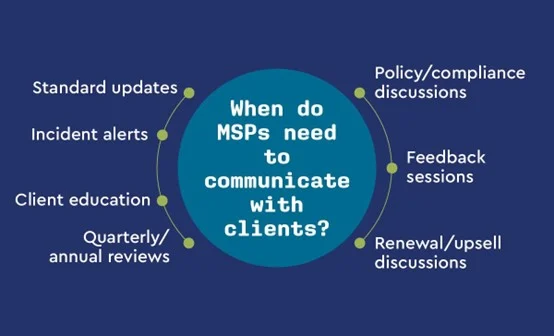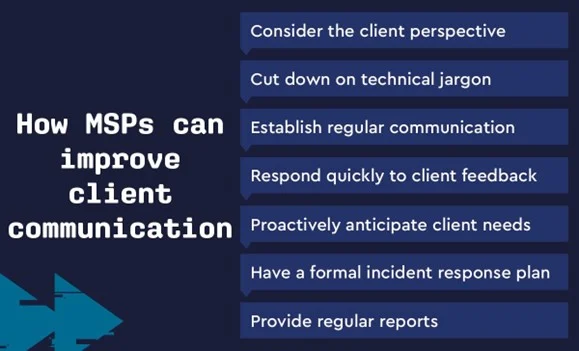Set up clear communication channels
Step one in improving client cybersecurity communications is setting up clear communication channels. This is best done through collaboration and inquiry. During your initial client consultation, gain a deeper understanding of their preferred methods of communication. Do they prioritize emails? Video calls? Collaborative platforms?
Once you’ve gained insight into their preferred methods, you can recommend a workstream that supports their capabilities. Remember to pursue secure, encrypted channels for sensitive communications or confidential information.
During your onboarding, choose a point of contact for any cybersecurity-related issues that arise. Having a clear point of contact is essential to ensure swift, efficient communication which is a key practice for what to do during a cyberattack.
For daily cybersecurity communication and updates, some MSPs like to use tools, such as Slack, Microsoft Teams, Trello, or Notion, for ongoing communication and task management. While these tools don’t replace the role of a phone or video call, they can help streamline workflows and provide transparency. Regardless of your decided method, set clear expectations about the communication channels to ensure alignment.
Simplify technical jargon and complex language
While we’ve mentioned the importance of simplifying technical jargon and speaking in plain language, in this section, we’ll take a deeper dive into how you can implement this for your clients.
Using plain language provides clients with the opportunity to truly engage with the information shared—instead of alienating them from the information provided. Clear information is also the linchpin of effective decision making, particularly in domains as intricate and dynamic as cybersecurity.
When you present your clients with precise, unambiguous information, it significantly impacts their decision-making process and mitigates the potential for analysis paralysis or general confusion.
Additionally, when clients have access to clear information, it empowers them with immediate decisions and actions instead of analysis paralysis or general confusion about next steps. Because not all clients have a technical background, simplifying technical jargon ensures inclusivity and caters to all stakeholders, regardless of their experience level.
What are some of the best ways to simplify technical jargon and complex topics? We typically recommend a few key strategies:
- Use analogies and metaphors: When explaining the concept of data security to a client, you might say: “Think of your data center like royalty in a castle—protecting them is a top priority. In this scenario, the first line of defense is an outer wall to keep anyone unwanted out. This wall represents your firewall and antivirus.”
- Provide visual aids: Providing visual aids, such as infographics, can be a helpful tool. Consider a fishing hook visual for phishing scams, a masked thief for malware, or a snooping character to denote spyware. For support in this area, the ConnectWise Partner Program provides non-branded assets for your team to add its brand and use.
- Offer step-by-step explanations: Another strategy is describing a process with step-by-step instructions. For example, if explaining how encryption works, you might say: “Imagine you’re sending a postcard, but before sending, you use a special code to rewrite it. Only the person who knows the code—on the receiving end—can decode and read the actual message. Step one is writing the message, step two is encoding it, and step three is the recipient using a key to decode it.”
- Hold interactive demonstrations: Interactive demonstrations are a highly effective tactic that can be used with clients. For example, an MSP can set up a virtual sandbox environment. Compare it to a hands-on workshop where the client can tinker with the software. Guide your client through the sandbox, letting them interact with each feature.
Because education is so critical for client success and longevity, construct educational resources to help support your clients. Build a content strategy and include different resources, such as webinars and workshops, guides and handbooks, monthly or bi-weekly newsletters, video tutorials, interactive platforms, case studies, and glossaries.
Best practices for preparing effective client education materials include keeping things simple, making sure items are tailored to your client’s industry, and offering multiple formats. Some clients may prefer webinars, others might like a handy PDF reference guide. Provide educational content in different mediums to ensure your client needs are met.
Communicating on risk and threats
Providing information on any risks or potential threats is a key part of any cybersecurity communication plan. Because cybersecurity threats move rapidly, proper and effective communication is necessary to keep clients informed. This means your teams must communicate both proactively and reactively for true security.
However, MSPs must strike a fine balance between providing details without instilling fear in your clients. The best strategy to share risk assessment findings or details on potential threats is to ground all communications in facts. Present information clearly and describe the threat, its potential impact, and its relevance to your client’s operations.
When sharing any information about risk or threats, consult your ransomware or data breach communication plan. Always accompany details of the threat with potential solutions or mitigation strategies to instill confidence in your client.
Incident communication
Handling and communicating incidents effectively is vital for MSPs to maintain trust and manage complex situations—and a critical part of an overall incident response plan. We recommend a three-stage process to communicate incidents to your clients:
1. Initial communication
As soon as an incident is detected, inform your client immediately. Delays can exacerbate the issue and erode trust. Offer a clear description of what is known about the incident and avoid any technical jargon. During this conversation, appoint someone on your team as the primary contact for the client and set expectations for what’s next in the process.
2. Response period
Once you’ve shared the initial details with the client, provide regular updates on the progress of the disaster response through scheduled calls or messages. Be transparent about the measures being taken to contain and resolve the issue. This keeps the client informed and reassured that active steps are being taken.
3. Post-incident updates
Once the incident is resolved, provide a comprehensive report detailing the nature of the incident, its causes, the impact, the response measures taken, and recommendations to prevent similar occurrences in the future. This is also a good time to schedule a meeting to discuss the report and answer questions with your client.
Be proactive with client questions and concerns
Proactive cybersecurity communication with your clients establishes an environment of trust, predictability, and reliability. By communicating clearly and responsively even when there is no active incident, you can build strong relationships.
Many MSPs struggle to define what warrants proactive communication and what doesn’t. We recommend communicating these core topics to your clients:
- Emerging threats
- Scheduled maintenance
- Industry news
- Regulatory changes
- New service offerings
- Periodic reports
Be careful to filter communication and resist inundating your client with unnecessary information. You can avoid frequent cybersecurity communication about irrelevant threats, frequent minor updates, and internal MSP news.
When handling client questions and concerns, lead with empathy and clear actionable steps. If your client voices a concern, listen actively, acknowledge their feelings, and provide clear answers.
Have a plan to address and process client feedback
Addressing and processing client feedback is fundamental to improving your services, nurturing long-term relationships, and driving business growth.
Feedback is a goldmine of insights for your organization. Without a plan to capture this feedback, MSPs miss a crucial opportunity for improvement. Consider these process points:
- Establish feedback channels: Develop surveys, feedback forms, and regular review meetings to make the process of providing feedback easy and straightforward.
- Categorize feedback: Organize all of the feedback you collect from different sources into different categories, such as technical issues, customer service quality, response time, and overall satisfaction.
- Develop a culture of continuous improvement: Cultivate a company culture that values feedback and sees it as an opportunity for growth—rather than criticism.
SmileBack, a ConnectWise solution, is the customer feedback system designed specifically for MSPs—and can help your organization develop a streamlined plan to address and process client feedback. Learn more about SmileBack here.
Prepare regular reports
Reporting is a pivotal tool for MSPs in communicating essential points and metrics to clients. This helps to crystallize complex data into digestible insights, which fosters transparency, trust, and informed decision-making.
One of the most important strategies to implement is Quarterly Business Reviews (QBRs). These meetings should be scheduled quarterly with the client to review the previous quarter’s activities, achievements, challenges, and forward-looking strategies.
Solutions to simplify cybersecurity communications
Effective cybersecurity communication is not only a helpful tool in securing client satisfaction and retention—but it’s also a mechanism that can significantly enhance the execution of your organization’s duties.
At its core, clear cybersecurity communication minimizes misunderstandings, supports informed decision-making, and helps to predict and mitigate potential issues. Many modern technology platforms offer a plethora of solutions that your organization can harness for optimal client service.
These can range from client management platforms, monitoring and analytics tools, automated reporting, collaboration tools, and feedback mechanisms. Determining the best tools for your organization is important for optimizing the client experience.
Whether you’re just starting your cybersecurity program or you’re looking to elevate your cybersecurity communication efforts, ConnectWise cybersecurity tools and platforms streamline daily operations and engage clients successfully. Try some of our cybersecurity software demos to see these features in action.










